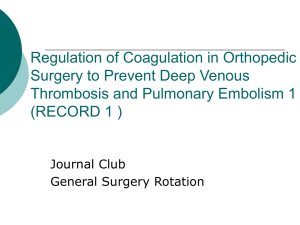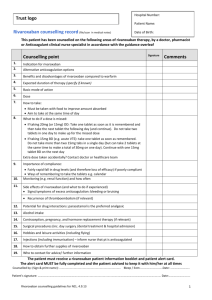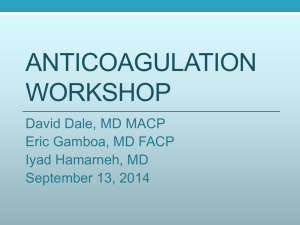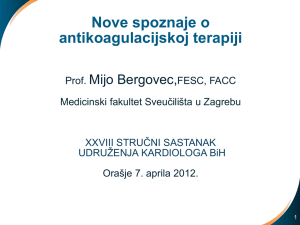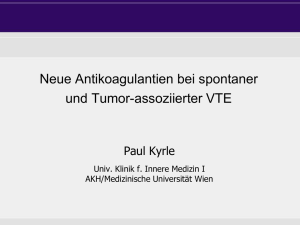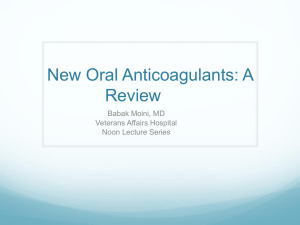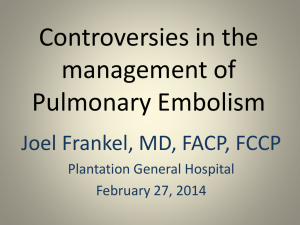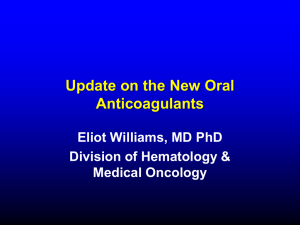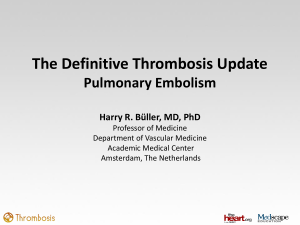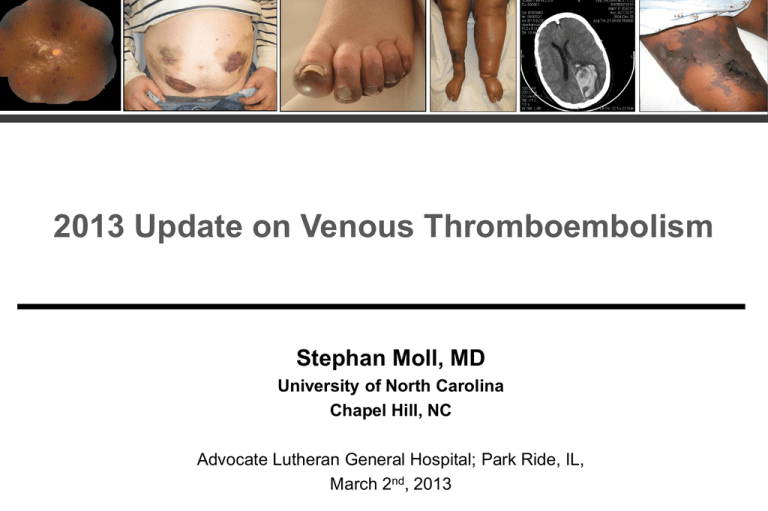
1 2 3 4 5
2013 Update on Venous Thromboembolism
Stephan Moll, MD
University of North Carolina
Chapel Hill, NC
Advocate Lutheran General Hospital; Park Ride, IL,
March 2nd, 2013
Disclosures
Consultant:
Janssen, Boehringer-Ingelheim, Daiichi
Speaker bureau:
none
The 3 Major Developments in 2012
I
Publication of ACCP Guidelines 2012
II
Approval of Rivaroxaban for VTE
III
Approval of Apixaban for atrial fibrillation
Patient
Diagnosis
few days
later
Q1:
Outpatient
or inpatient?
3 mo
any time
Case - PE
HPI
• 63 year old man, quite healthy
• 4 days h/o moderate CP + SOB; now SOB with 1 flight of stairs.
• No leg symptoms
• No preceding trauma, immobility, surgery, long-distance travel
PMH
• Arthroscopic knee surg 2 yrs ago
• HTN; Obesity (BMI 32.3)
• No h/o cancer; no h/o bleeding
FH
• Negative for VTE
Case
Physical Exam
• BP 135/87; P 92 / min
• RR at rest 16 min, not SOB when talking; O2 on RA 93 %
• BMI 32.3; lungs clear; legs R=L
CTA chest
• RUL segmental PE, L UL and LL subsegmental PE
Question – Outpatient vs. Inpatient?
Diagnosis
• Unprovoked PE. VTE risk factors: (a) obesity.
How to manage this patient?
A. Outpatient?
B. Admit?
ACCP 2012
Acute Treatment
• Recommend home treatment for DVT (1B) and
early d/c for low-risk PE. (2B).
[Kearon C et al. Chest 2012;141(2)(Suppl):e419S-e494S]
Outpatient vs. Inpatient – HESTIA Criteria
1. Hemodynamically unstable?
2. Thrombolysis or embolectomy needed?
3. Active bleeding or high risk of bleeding?
4. Oxygen needed to keep O2 saturation > 90 % for > 24 hrs?
5. PE dx’d during anticoagulant therapy?
6. iv pain meds for > 24 hrs?
7. Medical or social reason for admission?
8. GFR < 30 ml/min?
9. Severe liver impairment?
10. Pregnant?
11. Documented h/o HIT?
[Zondag W et al. J Thromb Haemost 2011;9:1500-7] [Zondag W et al. J Thromb Haemost 2013(Jan 6th )ePub]
[Aujesky D et al. Am J Respir Crit Care Med 2005;15;172(8):1041-6]
PESI = Pulmonary Embolism Severity Index
Outpatient vs. Inpatient – HESTIA Score
Teaching point #1
Outpatient PE management
• Suitable for, may be, 50 % of PE patients;
• HESTIA criteria can be useful for decision making.
Patient
Diagnosis
few days
later
Q1:
Outpatient
or inpatient?
Q2:
Thrombolytics?
3 mo
any time
Thrombolytics?
• For PE, with hypotension or high risk for hypotension: suggest
thrombolytics, systemically. 2C
• For DVT, suggest anticoagulant therapy alone over thrombolysis
(catheter-directed or systemic). 2C
[Kearon C et al. Chest 2012;141(2)(Suppl):e419S-e494S]
PE: Indicators of Poor Outcome
ESC criteria (based on consensus; lack of validation)
Criteria
High risk
mortality
Cardiovascular shock or
persistent hypotension
> 30 %
Intermediate risk Lab (troponin, BNP)
or RV dysfunction
1-30 %
Low risk
<1%
nl labs (troponin, BNP);
nl RV function
[Torbicki A et al. Eur Heart J 2008;2276-315]
Thrombolytics?
• PEITHO trial: 1,006 patients with RV stain PLUS pos. troponin:
thrombolytics versus placebo; results spring 2013.
• ATTRACT trial
392/692 patients enrolled as of Jan 8th, 2013.
[http://clinicaltrials.gov/ct2/show/NCT00639743?term=peitho&rank=1]
[http://clinicaltrials.gov/ct2/show/NCT00790335?term=ATTRACT&rank=1]
Patient
Diagnosis
few days
later
Q1:
Outpatient
or inpatient?
Q2:
Thrombolytics?
Q3:
LMWH/warfarin
or rivaroxaban?
3 mo
any time
Question –Anticoagulant Choice
Outpatient management is chosen. CBC, PT, aPTT normal; Creatinine
0.95; liver enzymes normal. How would you treat?
A. LMWH or fondaparinux / warfarin
B. Rivaroxaban (Xarelto)
C. Dabigatran (Pradaxa)
D. Apixaban (Eliquis)
New Oral Anticoagulants
Dabigatran
Rivaroxaban
Apixaban
tmax
1.5 - 3 hrs
2 - 4 hrs
1 - 3 hrs
Half life
12 - 14hrs
9 - 13 hrs
8 - 15hrs
80%
66 %
ca. 25 %
Renal
excretion
FDA
approval
• A. fib
[Garcia D et al. Blood. 2010 Jan 7;115(1):15-20. Review]
• A. fib
• A. fib
• VTE prevention
• VTE treatment
In clinical development: Edoxaban, Betrixaban (not FDA approved)
Rivaroxaban in Acute DVT and PE
A. DVT study
B. PE study
[Bueller H et al. NEJM 2010;363:2499-510]
[Bueller H et al. NEJM 2012;366:1287-97]
Rivaroxaban
BLEEDING
• Clinically relevant bleeding (composite of major and
clinically relevant non-major bleeding): Same.
• Major bleeding: Same (DVT study) or less (PE study).
[Bueller H et al. NEJM 2010;363:2499-510]
[Bueller H et al. NEJM 2012;366:1287-97]
Nov 2012
Rivaroxaban
In which patient do I consider rivaroxaban?
a) Acute DVT or PE
•
All patients treated as outpatients
•
Mild to moderate DVT; HESTIA criteria for PE
b) On long-term warfarin
•
I discuss it with all patients
•
Fluctuating INRs, high “warfarin hate factor”
Rivaroxaban
In which patient would I NOT use rivaroxaban?
• Renal impairment: GFR < 30 ml/min (or 40; “buffer zone”) by
Cockroft-Gault
• Liver disease
• Increased bleeding risk; particularly GI bleeding
• Acute cerebral vein thrombosis
• BMI > 40 or “low” body weight
• Cancer
• Patient who doesn’t like idea of “no known reversal agent/strategy”.
Rivaroxaban
Things to consider when starting rivaroxaban
• LABS: CBC, creatinine, AST, ALT, t. bili
• GFR > 30 ml/min
• Check with insurance carrier ($ 335 / month)
• 15 mg bid for 3 weeks, then 20 mg qd
• Take with food (AM or PM)
• Drug interactions: HIV meds, antifungal, sz drugs, St. John’s wort
• F/u with you in 3 weeks and in 3 months, then yearly.
Rivaroxaban
Teaching point #2
Acute or previous VTE: Rivaroxaban is a possible treatment option.
Other Drug Approvals in 2012
Apixaban in Atrial Fibrillation
[Granger CB et al. N Engl J Med 2011;365:981-92]
Apixaban in Atrial Fibrillation
Apixaban…
a) is MORE effective than warfarin
b) leads to LESS major bleeding.
Dec 2012
Hospital Guide for New Oral Anticoagulants
Dabigatran:
http://www.med.unc.edu/im/staff/clinic/files/Dabigatran%20Management%20-%20PDF%20%20Updated%20201111.pdf
Rivaroxaban:
http://professionalsblog.clotconnect.org/wp-content/uploads/2012/05/UNC-Xarelto-2012.pdf
Apixaban:
http://patientblog.clotconnect.org/wp-content/uploads/2013/02/Apixaban-UNC-2-2013.pdf
Teaching Point #3
Comprehensive management documents:
: UNC and rivaroxaban
New Oral Anticoagulants: Cost
• Per day:
$ 9.20 to $ 11.20
(ca. $ 10.00 /day)
• Per month: $ 276.00 to 336.00 (ca. $ 300.00 /mo)
[personal communciations: evaluation of Average Wholesale Price (AWP) and inquiry from 3 national pharmacy chains; Jan 28, 2013]
VTE Brochure
[http://files.www.clotconnect.org/DVT_and_PE.pdf]
VTE Brochure
Teaching point #4
www.clotconnect.org
Patient
Diagnosis
few days
later
Q1:
Outpatient
or inpatient?
Q2:
Thrombolytics?
Q3:
LMWH/warfarin
or rivaroxaban?
Q4:
Compression
stockings?
3 mo
any time
Compression Stockings?
SOX trial
[Kahn SR;ASH 2012;abstract 393]
Teaching point #5
Compression stockings probably/possibly do not prevent PTS.
Patient
Diagnosis
few days
later
Q1:
Outpatient
or inpatient?
Q2:
Thrombolytics?
Q3:
LMWH/warfarin
or rivaroxaban?
Q4:
Compression
stockings?
3 mo
Q5:
D/c anticoag or
long-term?
any time
How Long To Treat With Anticoagulation?
VTE due to transient risk factor
Woman with DVT, not hormones
Woman with PE
Long-term
- D-dimer +
Woman with DVT or PE, hormones
Strong
Thrombophilia
3 months
Man with DVT
Man with PE
Other risk factors for recurrence: Obesity?; age?
Other considerations: Bleeding, fluctuating INRs, lifestyle impact, pt
How Long to Treat with Anticoagulation?
[Palareti G et al. NEJM 2006;355:1780-9]
[Verhovsek M et al. Systematic review on D-dimer to predict recurrent VTE. Ann Int Med 2008;149(7):481‐490]
VTE Recurrence – Risk Assessment Scores
HERDOO-2 score
[Rodger M et al; CMAJ 2008;179:417-426]
DASH score
[Tosetto A et al. J Thromb Haemost 2012 Jun;10(6):1019-25]
How Long to Treat With Warfarin? - HERDOO-2
Women
HERDOO-2 rule
•
HER =
•
Hyperpigmentation or
•
Edema or
•
Redness
•
D = D-dimer positivity (on warfarin)
•
O= obesity, BMI ≥ 30
•
O = Older age, ≥ 65 yrs
•
2 = score of ≥ 2: continue warfarin
[Rodger M et al; CMAJ 2008;179:417-426]
Conclusion:
• Women
≤ 1 d/c anticoagulation.
• Men, no matter what the score, need
to continue anticoagulation.
How Long to Treat With Warfarin? - DASH
DASH score
• D = D-dimer pos (off warfarin) + 2
• A = age < 50 years
+1
Conclusion:
• S = sex (male)
+1
• Score ≤ 1: d/c anticoagulation
• H = hormone use
-2
Annual VTE recurrence rate:
• ≤ 1:
3.1 %
• 2:
6.4 %
• ≥ 3:
12.3 %
[Tosetto A et al. J Thromb Haemost 2012 Jun;10(6):1019-25]
Patient‘s Preference
“Coumadin hate factor”
0
10
VTE: Length of Anticoagulation
Conglomerate decision of:
1. Risk of recurrent VTE
(a)…., (b)…., (c) …..
2. Risk of Bleeding
(a)…., (b)…., (c) …..
3. Patient preference
“Coumadin hate factor”
ACCP 2012 Guidelines: Highlights
Treatment beyond Acute Period
• Surgery-associated DVT/PE: recommend 3 months. (1B)
• Non-surgical transient risk factor: recommend 3 months over 6 or
more months. (1B)
• Unprovoked DVT/PE and low/intermediate risk for bleeding: suggest
extended anticoagulation (2B). High bleeding risk: 3 months (1B).
• Cancer patient with DVT/PE: recommend/suggest extended therapy.
LMWH rather than VKA (2C).
[Kearon C et al. Chest 2012;141(2)(Suppl):e419S-e494S]
VTE: Length of Anticoagulation
Teaching point #6
How long to treat with anticoagulation?
• Risk factors for VTE: (a)…., (b)….., (c)……
• Risk factors for bleeding: (a)…., (b)….., (c)……
• Patient preference
Patient
Diagnosis
few days
later
Q1:
Outpatient
or inpatient?
Q2:
Thrombolytics?
Q3:
LMWH/warfarin
or rivaroxaban?
Q4:
Compression
stockings?
3 mo
Q5:
D/c anticoag or
long-term?
Q6:
Warfarin or
rivaroxaban?
any time
Rivaroxaban in VTE, Secondary Prophylaxis
VTE extension study
[Bueller H et al. NEJM 2010;363:2499-510]
Patient
Diagnosis
few days
later
Q1:
Outpatient
or inpatient?
Q2:
Thrombolytics?
Q3:
LMWH/warfarin
or rivaroxaban?
Q4:
Compression
stockings?
3 mo
Q5:
D/c anticoag or
long-term?
Q6:
Warfarin or
rivaroxaban?
Q7:
Aspirin vs
anticoagulant?
any time
Aspirin and VTE Prevention
A. WARFASA study
HR 0.58
95% CI 0.36 to 0.93
p= 0.02
placebo
aspirin
[Becattini C et al; NEJM 2012; 366:1959-1967]
B. ASPIRE study
[Brighton TA, et al. N Engl J Med. 2012 Nov 22;367(21):1979-87]
Aspirin and VTE Prevention
Aspirin and VTE Prevention – Meta-Analysis
C. Meta-analysis
[Brighton TA, et al. N Engl J Med. 2012 Nov 22;367(21):1979-87]
ASA and VTE
Teaching point #7
• Not clear whether Aspirin prevents recurrent VTE.
• But it does lead to a net “vascular benefit” (arterial and venous
together).
Patient
Diagnosis
few days
later
Q1:
Outpatient
or inpatient?
Q2:
Thrombolytics?
Q3:
LMWH/warfarin
or rivaroxaban?
Q4:
Compression
stockings?
3 mo
Q5:
D/c anticoag or
long-term?
Q6:
Warfarin or
rivaroxaban?
Q7:
Aspirin vs
anticoagulant?
any time
Q8:
Surgery
When to d/c at Times of Surgery
Renal function
[CrCl, mL/min]
Half-life
[hours]
When to stop drug before surgery
(after last drug dose)
Standard
bleeding risk
High bleeding
risk
Dabigatran
> 80
13 (11-22)
24 hrs
2-4 d
> 50 to ≤ 80
15 (12-34)
24 hrs
2-4 d
> 30 to ≤ 50
18 (13-23)
≥2d
4d
≤ 30
27 (22-35)
2-5 d
>5d
Rivaroxaban
>30
12 (11-13)
24 hrs
2d
< 30 mL/min
Unknown
2d
4d
[UNC 2013 treatment guidelines]
When to d/c at Times of Surgery
Apixaban
• No published data exist on optimal perioperative
management
• d/c ≥ 24 h or ≥48 h prior standard / high risk procedures
Teaching point #8
For all new oral anticoagulants: D/c before surgery: 24 hrs for standard
risk surgery; 2-4 d for high risk. Consider renal fx.
Patient
Diagnosis
few days
later
Q1:
Outpatient
or inpatient?
Q2:
Thrombolytics?
Q3:
LMWH/warfarin
or rivaroxaban?
Q4:
Compression
stockings?
3 mo
Q5:
D/c anticoag or
long-term?
Q6:
Warfarin or
rivaroxaban?
Q7:
Aspirin vs
anticoagulant?
any time
Q8:
Surgery
Q9:
Major bleed
Major Bleeding – Reversal, Management?
Best strategy not known
Problem with existing data:
•
NO meaningful patient data published
•
Animals: Mice and rat tails
•
Human volunteers: reversal of coagulation tests
•
Ex vivo plasma spiking tests: reversal of coagulation tests
•
Mice intracranial bleeding model
[Zhou W et al. Stroke 2013:44:ePub]
Major Bleeding
Treatment Options
1. Supportive care!
2. Activated charcoal
3. Hemodialysis for Dabigatran, not for Rivaroxaban or Apixaban
4. No clotting factor therapy
Major Bleeding
Treatment Options
5. Non-activated PCC (prothrombin complex concentrate)
6. Activated PCC
7. Recombinant factor VIIa
8. FFP
9. Anti-fibrinolytic drugs (aminocaproic acid, tranexamic acid)
Summary
1. Outpatient VTE management
• Suitable for, may be, 50 % of PE patients;
• HESTIA criteria for PE risk can be useful for decision making.
2. Rivaroxaban for VTE (acute; previous): possible treatment option.
3. New oral anticoagulants
• Starting the drugs;
• D/c before surgery (24 h for standard risk; 2-4 d for high risk;
• Major bleeding management.
Summary
4. VTE Patient brochure available
5. Compression stockings probably/possibly do not prevent PTS.
6. How long to treat with anticoagulation?
• Risk factors for VTE: (a)…., (b)….., (c)……
• Risk factors for bleeding: (a)…., (b)….., (c)……
7. Aspirin: Not clear whether it prevents recurrent VTE. I do
encourage the use.

